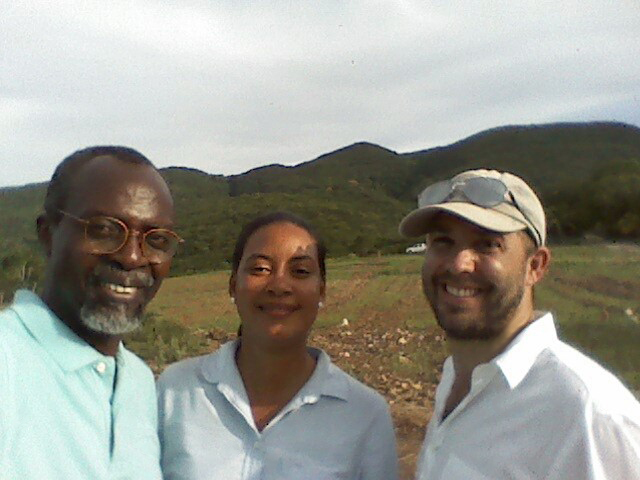This is part one of a two-part blog post about a new project in Jamaica aimed at simultaneously improving the island nation’s energy production, waste disposal, and agriculture.
By Wale Adewunmi
In Jamaica, tourism fuels the country’s economy. However, it also probably generates more waste than any other industry on the island. A new Thriving Earth Exchange project is working to convert food waste from resorts into biogas to provide useful energy. A byproduct of making gas from this troublesome waste stream, after it is mixed with animal manure, is a fertilizer rich in nutrients and organic matter that releases its nutrients slowly.
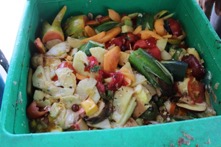
When microbes in a covered pit known as a digester break down food leftovers like these that have been mixed with animal manure in the digester, the process produces methane gas that can be used to make electricity. Credit: Wale Adewunmi
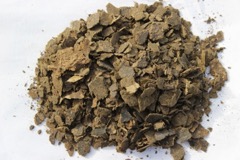
When dried, the liquid residue from waste’s digestion forms flakes of nutrient-rich fertilizer that CaribShare Biogas plans to sell to farmers to fund the project. Credit: Wale Adewunmi
I’m Wale Adewunmi, the volunteer scientist who has been assisting the CaribShare Biogas project. My specialties are the environmental chemistry of soils and managing waste in soil, as well as reclaiming and remediating contaminated soils. I’ve spent many years working on treatment of sludge and various ways to use biosolids (treated sludge) in soil, most recently as the head of a U.S.A.-based consulting company Binomial Associates, LLC.
On the Jamaica side, Carol Lue leads the project as executive director of CaribShare Biogas, a socially minded business that has developed Jamaica’s first biogas electricity generation plant. The U.S. Agency for International Development (USAID) and its country representatives, ACDI/VOCA are funding partners with the company.
On the Spot
I’ve worked with CaribShare Biogas remotely since the beginning of February of this year. During my first in-person visit to the project’s Montego Bay site early this summer, I became acquainted with the project’s digester, where microbes break down the waste and produce gas that’s used to generate electricity plus a liquid residue that can be used as fertilizer as is or after it is dried. While visiting the project, I noticed Jamaican soils that sorely need such fertilizer and met most everyone involved with this innovative effort, including interested farmers.
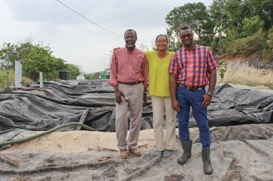
Wale Adewunmi (left), CaribShare Biogas founder and executive director Carol Lue (center), and Courtney Taylor, regional manager of the Trelawny Parish Rural Agricultural & Development Agency visited CaribShare Biogas’s digester in June, shortly before it was upgraded. When the digester is operating, the gray, tarp-like canopies that lie open and rumpled in this image tightly cover and seal the pit. Credit: Wale Adewunmi
In one round of meetings, Carol and I visited with regulators and laboratory officials at the Bureau of Standards Jamaica (BSJ), in Kingston, an agency that sets product labeling requirements and provides testing services needed to assess the fertilizer’s safety and nutrient composition. We consulted with the Bureau’s testing laboratory to review its ability to perform the tests required to characterize the digester product. Testing for some parameters were eventually completed, but some were delayed by instrument breakdown.
In the end, we got some data from the laboratory to work with and to embark on the next stage of the project. Additionally, we met with another company to assess their ability to meet our testing needs and for comparison with BSJ laboratories.
I felt that the face-to-face exchange at the Bureau was more productive than if we had relied on electronic methods of communication. In Kingston, we also met with representatives of USAID and ACDI/VOCA.
Enriching the Soil
“Testing verifies the concentrations of nitrogen, phosphorus, and potassium in the fertilizer to determine the nutrient value (or strength), as well as what should be the application rates,” Carol noted. “The BSJ results show that the fertilizer is very high in nitrogen relative to phosphorus and potassium, as is common in many fertilizers.”
“These are not pass-fail tests. The project will continue to test on a quarterly basis to confirm consistency in fertilizer composition for quality-control purposes,” she added.
The advantages of the organic fertilizer that the project produces are many. It’s environmentally friendly by cycling natural resources back into the soil from whence they came, thereby diverting them from the landfill. Soils in St. James Parish, where CaribShare was founded, and in neighboring Trelawny Parish, a new and additional area of service for the project, are derived from white limestone and marl, the latter being a material that’s about half clay and half chalky calcium carbonate. When a new field is cleared for agriculture, horticulture, or land operation, the topsoil layer is lost and the limestone and marl are exposed. These soils need large quantities of organic matter, another important component of CaribShare’s fertilizer, to slowly build up the topsoil or plow layer.

Beneath the top soil in the area of Jamaica where the project is taking place, the ground contains mainly white limestone and marl. When these materials form the surface of a new area to be planted, the earth needs enrichment with organic material for it to support high yields of healthy crops. Credit: Wale Adewunmi
Cultivating Customers
I was glad to help usher the fertilizer development along during my visit. I also witnessed strides being made in the product’s promotion to farmers.
We met one afternoon with the Trelawny Parish (County) Agricultural Manager of the Rural Agricultural & Development Agency (RADA) to connect with farmers and make plans for a field demonstration. This also enabled us to build and reinforce the working relationship between CaribShare Biogas and RADA.
The agency works closely with farmers and is best positioned to connect us with them. Having RADA by
our sides helps us to bring this fabulous organic fertilizer to the farmers. We and Courtney Taylor, the RADA representative, discussed various aspects of the fertilizer, crops, planting, and farmers in the area who are most likely to benefit from this project. Farmers were identified to be contacted and an approach was agreed.
Especially exciting is that, in addition to farmers identified by RADA, CaribShare Biogas has a couple of large-scale commercial farmers as potential users. We visited one of them, Robert McKinney, Technical Director of Rose Hall Developments. He operates his company’s 4,000-acre farm located in the hills with impressive views of the shoreline from the distance. McKinney is an environmental engineer, and we reviewed with him soil test results and organic fertilizer data. We also discussed the compatibility of the organic fertilizer with his operations.
One of the advantages of CaribShare Biogas’s fertilizer to this farm is our proximity. Reducing transportation time increases the number of loads of fertilizer a farmer can quickly apply to his land, saving time and labor costs. McKinney also visited the CaribShare Biogas facility to see the operations and is eager to use this fertilizer, especially in liquid form, which saves CaribShare Biogas from having to dry it first.
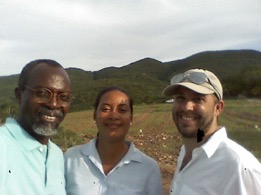
Wale Adewunmi and Carol Lue met with farmer and environmental engineer Robert McKinney (right) of Rose Hall Developments about the company’s 4,000-acre farm in St. James Parish.
Said Carol, “Based on our supply capacity, we are looking to partner with a few large-scale farmers to provide our anchor fertilizer sales and better ensure financial viability. In addition, for our social mission of strengthening the livelihood of farmers, we are looking for our fertilizer uptake to be 50 or so farmers from the surrounding areas.”
In the near future, the project will conduct one or more field demonstrations with RADA officials to introduce farmers to the fertilizer, show them how to use it in the field, answer their questions, and get their feedback. “We are in the initial stages of our field demonstration program,” Carol noted. “In a few months, once our initial participants have seen the benefits of our fertilizer and can provide testimonials, we will then be looking to further promote and expand the program.”
Stay tuned for Part 2!

